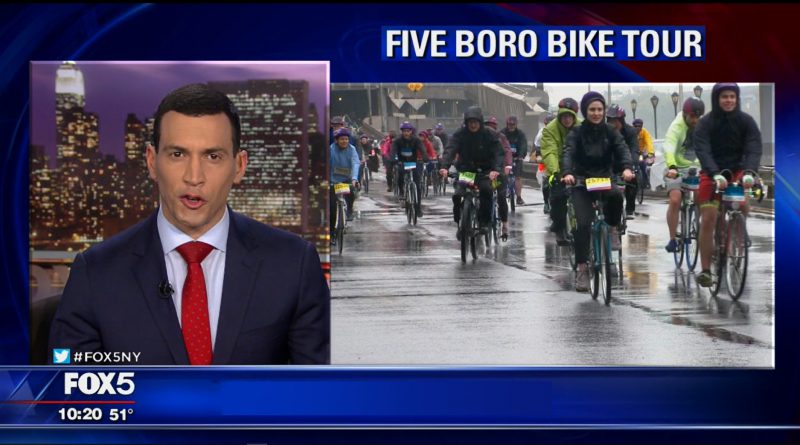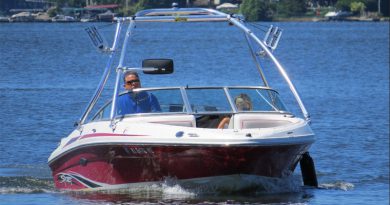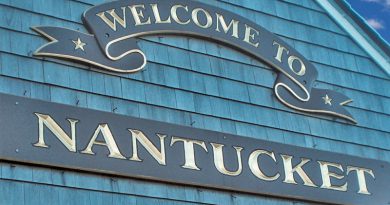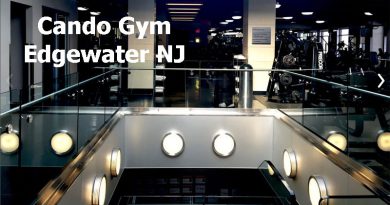Confessions of a Five Boro Bike Tour Marshal
The TD Bank New York Five Boro Bike Tour From a Marshal’s Perspective
The New York Five Boro Bike Tour is a 40 mile bike ride that attracts 32,000 riders each year and they get to ride a closed-course of major highways through the five boroughs of New York City. The route includes Sixth Avenue, Central Park, Madison Avenue Bridge, 3rd Avenue Bridge, FDR Drive, Queensborough Bridge, the BQE and the lower section of the Westbound lanes of the Verrazzano Bridge. Fort Wadsworth in Staten Island is used for the finish festival. The event takes place on the first Sunday in May each year.
First 500 Riders Think it is a Race
Even though the tour is a strictly a “tour” around the Five boroughs of New York City, many participants figure that it is in fact a bike race and they should go hell for leather right from the very start. One year, the host on the start-stage accidentally called it a “race” which created a huge problem with cyclists jockeying for position from the opening gate. The first 500 riders are often an obnoxious bunch of competitive yahoos, who make the start of the tour a nightmare for staff and other riders who are just there to enjoy it. Pushing and shoving during the ride is normal for them and the organizers do nothing to control their actions. One only needs to see them in the Central Park South section, which is where they become their most boorish in the narrow lanes. At that point they have overtaken the charity and VIP riders that were allowed to start ahead of them and now no one is holding them back.
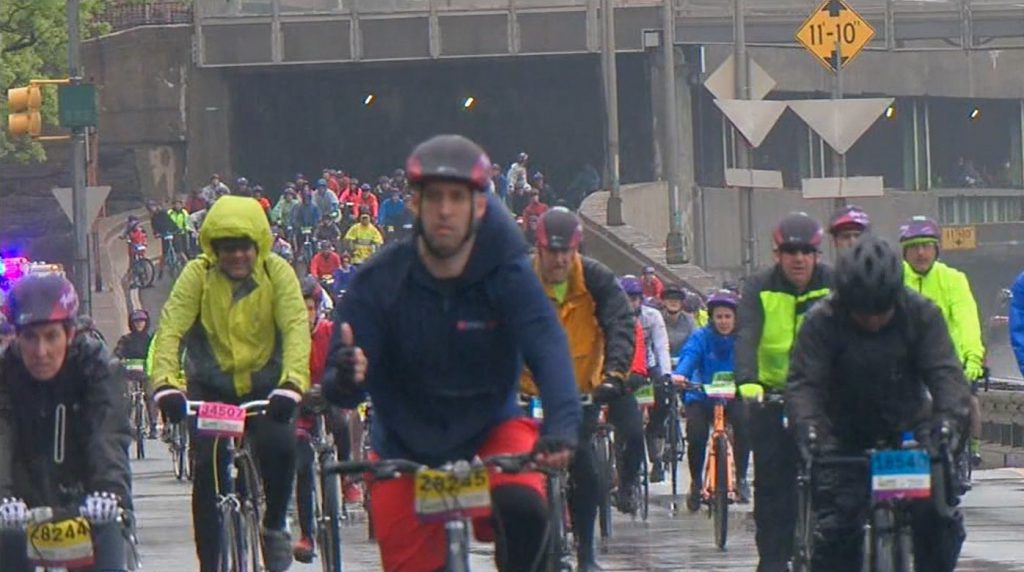
Where Are The Most Accidents On The Tour?
The start of the course is where the most bike accidents happen. People are crammed in at the start and are getting anxious to go, which leads to crashes when the tour finally starts – but most accidents here are low speed, so injuries are usually pretty minor.
The next worst place is Central Park South. The bike tour has now been broken up into two different routes in the park (instead of one) to reduce the risk of crashes. Central Park South is the first place on the tour where there are some hills and riders often go too fast and are too close together. They are also testing their brakes for the first time in the ride. During the Central Park section all riders should keep a good distance from the person in front due to the horse manure that gets kicked up by the bike tires, which is especially bad in the rain. It is gross, it tastes awful and is a big medical risk.
Inside the tunnel on the FDR lies the hidden nightmare of the metal plates in the road that redirect bicycle tires at the mere sight of water or thin tread. This dangerous location has been better managed in recent years, but the mayor should do something about it. Watch for the warning lights on the ground and tread lightly through this area or you could find yourself eating a tarmac sandwich with the few teeth you will have left.
When it rains, regular block brakes will often fail to work, but disc brakes may still be OK, albeit with a bit of a squeal, which means that anywhere on the tour can be accident prone in the rain, but it is especially dangerous on bridges on the climb and their descent.
No One Ever Dies on the Five Boro Bike Tour
Despite many medical incidents, no one ever “officially” dies while riding the Five Boro Bike Tour. The normal practice is that their death is attributed/ reported at one the local hospitals that they will be brought to and the tour is not cited as the location of their death. The most common cause of death is, not surprisingly, a heart attack. Participants who have had little training are more prone to this as are riders with heart conditions.
Most heart attacks happen at one of the first bridges, either the Madison Avenue Bridge or the Third Avenue Bridge. What is surprising is that if a person suffers a heart attack at one of these two locations, they usually survive, as EMT is right there and the stress of the climb is only medium. These bridges claim just 0.3 deaths on average, per year. The most prolific killer is the next bridge, which is the wolf-in-sheep’s clothing, Queensborough Bridge. This bridge of death claims, on average, 1.3 victims per tour and this is the one to watch out for anyone with a weak heart. There is no shame in walking up it,
By the time the huge Verrazzano Bridge is reached, which is at the very end of the tour, most unfit riders have already bailed out, which reduces the death rate considerably. The Verrazzano Bridge has a monstrous climb to the finish in Staten Island and this bridge surprisingly only claims 0.6 riders on average per tour. Many riders are too puffed out by then to ride up it and about a third of them walk up. Some riders die at the finish festival (0.1 per year) and some on the return trip via the Staten Island Ferry, directly following the tour (0.2 deaths per year)
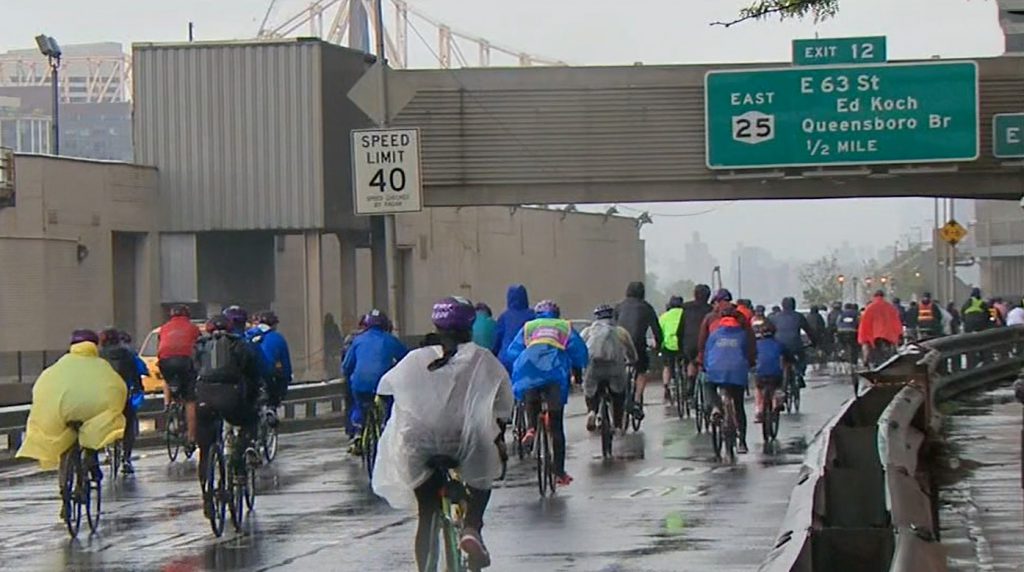
Rain Drives Participants Away
The Five Boro Bike Tour usually has 32,000 riders. An extra 400 volunteers ride with the tour to help with accidents and mechanical problems. When it rains, there are a great deal of no-shows. In the 2016 and the 2019 rides, which had rain all day, the rider numbers were very low. In 2019, 32,000 people had signed up for the tour, but only 19,000 riders actually started the tour and only 9000 of them finished it. In the rain, no one stays at the finish festival because the tour doesn’t ever plan ahead with tents or heat. The various food concessions lose a huge amount of money and without any respite from the weather, the whole bike tour experience is made both harsh and unfriendly. The tour could benefit from having some sort of rain/cold plan at the end of the tour, which would be a heated and dry oasis, instead of the cold muddy mess that exists when it rains hard today.
The Best Snacks On The Ride
Water and snacks are everywhere on the ride and no rider will go hungry or thirsty. There are four main rest areas located along the route that provide cyclists with snacks and water, but there are many in-between stations too. The rest areas also have toilets and bike repair. In each of the rest areas there are also bananas, apples and packaged snacks like nuts or granola bars. The one rest stop where there is a ton of free food is at the Commodore Barry Park in the Fort Greene neighborhood of Brooklyn. There are so many freebies there that riders bring large bags or baskets and fill up for the whole cycling season with every bike snack you can think of including Clif Bloks, Bonky Bars, Krave Jerky, NAI Nature Addicts Snacks and GU Roctane Gel. Anyone with a ridiculous or dumb brand name can get established by giving away their product for free here. It’s the quickest and cheapest way to get the product into the hands of biking influencers.
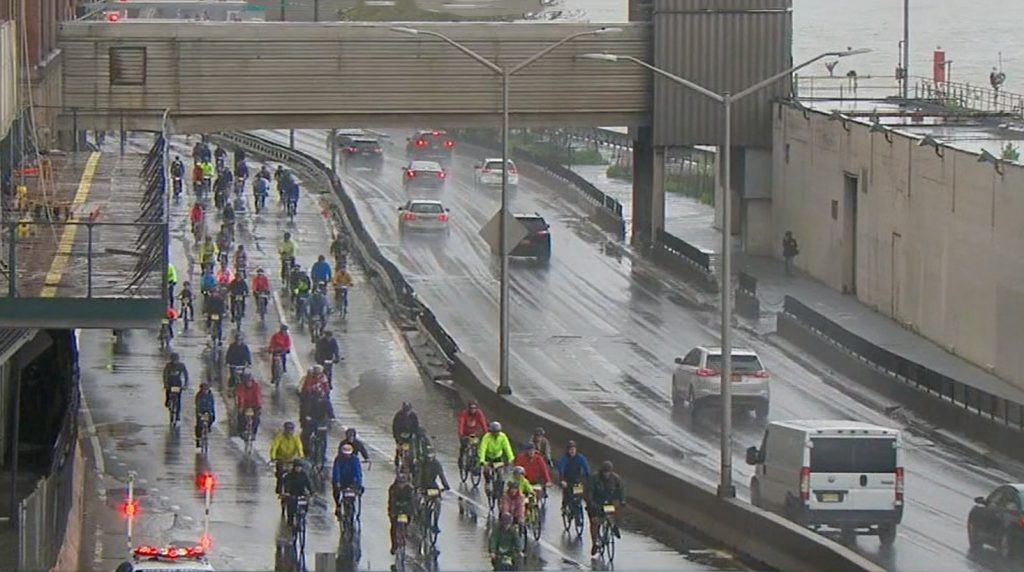
Prices For Tour Tickets on Craigslist Drop Quickly
If the weather is expected to be good, then tickets being resold on Craigslist usually sell for their face value as the ride day approaches. It has been suggested that the tour organizers should refund the original ticket buyers that cannot make it and allow tickets to be sold for a slightly higher price to a standby list, but they do not do this, so secondary market ticket sales happen a lot.
If rain is forecast then all bets are off. Prices for tickets on Craigslist drop precipitously and there are significantly more sellers than buyers. Prices for the the 1st wave drop to $50. 2nd wave tickets drop to $35 and the 3rd and 4th final waves drop to a mere $25 each. When it rains the organizers actually combine the final two waves anyway. The sought-after VIP tickets drop to $100, which is a bargain if you have good rain gear, good fitness and stamina, as you will get into a VIP tent at the end, while all others are forced outside in the rain and cold, including the marshals.
TD Bank Sponsor Is Actually A Canadian Company
They call themselves “America’s Neighborhood Bank” but TD Bank is actually the “Toronto Dominion Bank” and its a Canadian born organization. This is the same bank that had the 2012 data breach where they misplaced data that included bank account numbers and SSN’s for approximately 270,000 bank account holders. In October, 2015, a class action lawsuit was filed against TD Bank claiming that it violated the Telephone Consumer Protection Act by calling consumers up to 10 times a day, but the July 2017 case was tossed out by Judge Jerome B. Simandle. Despite being a Canadian bank, TD Bank customers reported that the bank also blocks purchases of bitcoin and other cryptocurrency transactions.
No Penalty For Bad Participants and No-Shows
The tour used to allow over 50,000 participants, but now it is limited to just 32,000 riders. This means that there are many more riders than there are spots, but the tour organizers do not kick off any of the bad participants.
The most common problem is no-shows, which is especially true when it rains. No-shows should be charged an extra fee or not allowed on the tour the following year as there may be plenty of other people that would like to ride the tour, but they blocked them.
The most common infringement on the day is participants who knowingly go onto a starting wave that is not their own. Course marshals will ask them to move to their own wave, but situations can often develop and they will often want to get in a fight with Marshals about it. These participants should be booted from the tour, but tour organizers continue to allow them to ride each year.
In each wave, the riders numbers are electronically recorded by RFID and organizers know exactly who went off in the wrong wave. Many regular riders sneak into the charity and VIP sections, in order to get a better position at the start, but organizers do nothing with that data and allow the problem to get worse each year – making the job of marshals even harder. It has come time to ban these riders from the tour.
Some riders actually fight each other during the ride and things can often get serious very quickly. Tour organizers care very little this and suggest to make it a Police matter, but the Police do not report back their findings to the tour organizers, even if they did tour organizers would probably do nothing anyway. It has probably come time to kick off bad participants off the tour and let in riders that do want to comply. The tour is popular enough that it can be picky when it comes to conduct. It needs some leadership from the top and no one seems to know where that is.
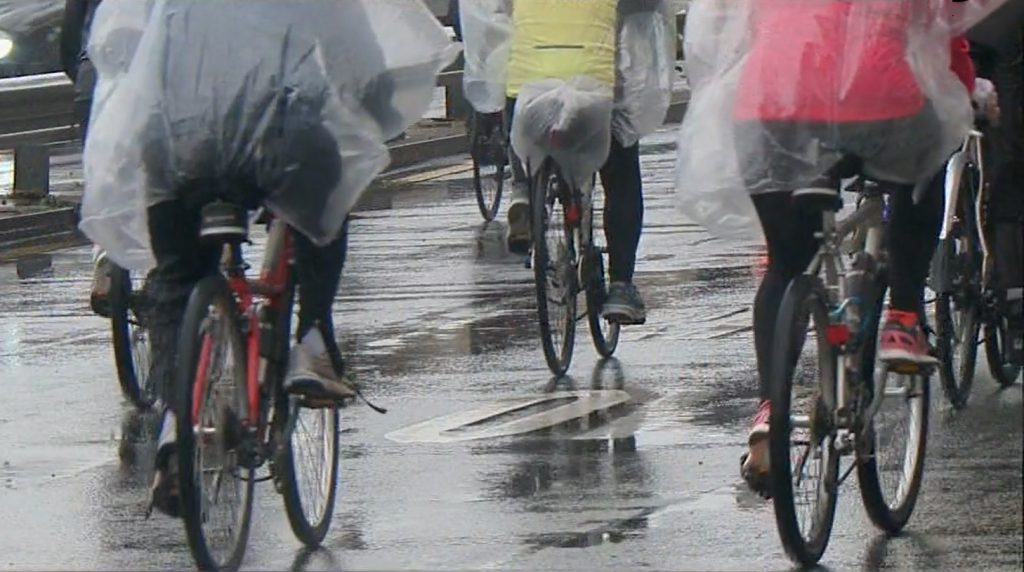
No Penalty For No-Show Volunteers and Marshals
Officially there are 1200 volunteers for the Five Boro Bike tour. One quarter of that that number are static volunteers, that are located in a single spot for the whole event. Of that number, a majority are individuals who are just filling up their hours for court mandated probation and community service hours. In the event of rain, a huge number of these people do not turn up. For the volunteers that do turn up, the duties from the no-shows need to redistributed to them, which makes operations on the day of the tour very difficult. No penalty is assessed to any volunteer that does not turn up, which means they are free to apply again the next year, despite being wholly unreliable. Similarly, volunteers that do turn up during bad weather are not given any extra credit or thanks for doing so.
Secret Alternative Routes For Marshals
Long-in-the-tooth course marshals know that they can get away with pretty anything they want to on the ride day, as they are unpaid and are given many difficult tasks and very few resources. One of these benefits include making up their own routes to get around rider backup at key bottlenecks around the city. This is especially true at the Bronx Bridges and the Queensborough Bridge.
The first alternative route is to ditch The Bronx completely and cut over to the FDR at 116th Street. The second alternative route is exiting the FDR at 71st Street and heading down 2nd Avenue to the Queensborough Bridge.
The third alternative route is after the finish festival in Staten Island, using the back roads to get to the Marshal entrance at the Staten Island Ferry. A bonus route is to exit the finish festival by the back door located at the First Aid tent, which means avoiding the throngs of people at the finish festival and all the mayhem that usually transpires there.
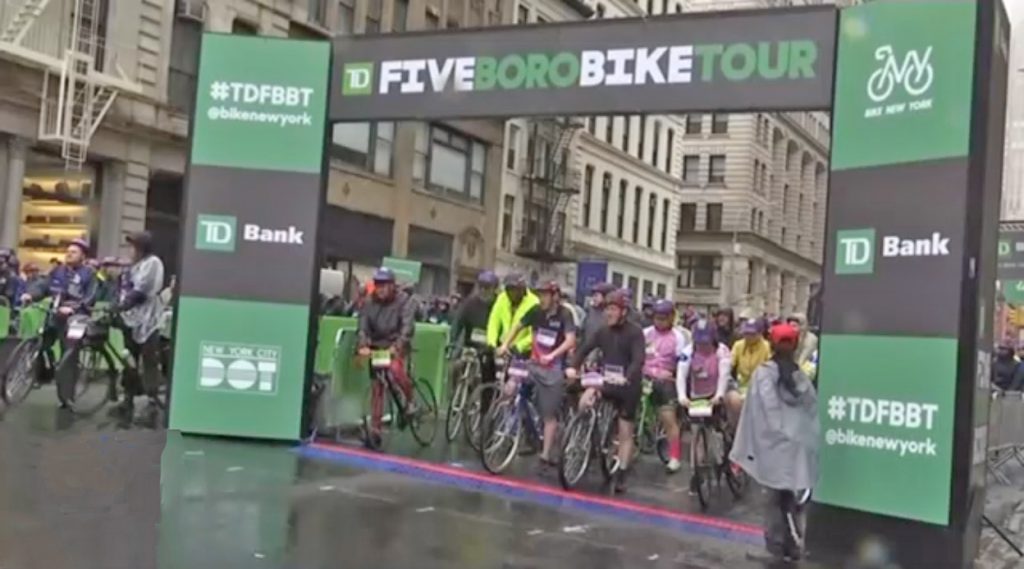
Marshal Responsibilities
Being a marshal is not a glamorous assignment. At the start of the job, marshals are assigned a fixed task like attending an intersection, controlling crowds or giving directions/instructions. Captains give out these roles and often ask marshals to do work that they will not do themselves EG “Please carry these 22 barriers five blocks South” was a recent request.
Once a task is complete, Captains then put marshals on other tasks or release them. Many Captains just take off riding themselves and the marshals are standing around wondering what they are supposed to do.
Once the tour has started and marshals have been released, the role then changes to providing assistance to riders during the tour. Marshals can be dealing with all sorts of problems, but most are bike accidents, flat tires, lost children separated from their parents, detached bike chains, broken brakes, dropped rider gear in the road that needs to be picked up (like water bottles and mirrors) and so many other types of problems.
The most difficult problem to deal with is the medical emergency. Marshals have to be able to attend to a person in distress and try to help them avoid being run over by 32,000 other riders, who cannot see them lying on the ground because they are below eye level. The tour teaches marshals to form a wedge to protect them, but organizers clearly have never tried this in real life, especially in fast riding areas. It is a game of real-life Frogger, just the stakes are a great deal higher.
The Marshal Area At The Finish Festival Is Poor
The marshal area at the finish festival in Staten Island is a pretty poor spectacle. The marshals are usually pretty dirty from the ride (from helping at any number of situations that involved blood, oil and tears) and all they get is a portable toilet to clean up in, just like everyone else. If it rains they expect marshals to eat their free sandwich in the downpour and then just clear off with their lousy free tee shirt.
This should be a great opportunity to thank marshals for their work and create some camaraderie with their peers. In many cases this will be the last time marshals will see each other for a year, but they are treated quite poorly here. The opportunity to ensure that marshals keep coming back is lost and this is especially true of marshals who turn up in the rain, what thanks do they get? The answer is none.
Charity and VIP Riders Are Always in Front of First Wave
Most people do not realize that charity and VIP riders are placed ahead of the first wave riders. This leads to confusion on the ground on the day of the ride and trouble on the roads as many first wave riders will blast past the VIP riders as soon as the gate is open. Even before the gate is open, first wave riders see hundreds of people lined up ahead of them and they try to move up there. Managing this crowd becomes like a cowboy herding cats, and it does not help that many of the marshal captains are not particularly good. Just how do captains get their jobs, as it does not seem to be based on ability?
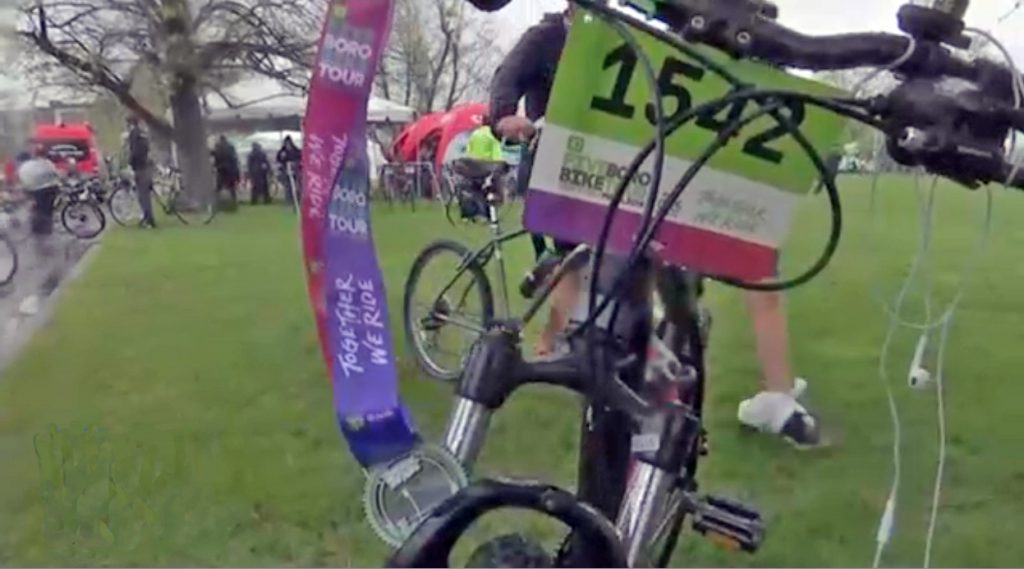
What Bikes Are Best For The Tour?
Common bike brands that are great for the Five Boro Bike Tour are Cannondale, Trek and Specialized. These bikes have good components and are reliable enough to get riders to the end of the tour without mechanical problems. They also do not cost very much. Giant and Scott are decent bikes, but too many of them are still seen on the road side with some kind of problem or another, often a lower bracket failure or a derailleur break. The cheaper chains on these bikes will often break and can result in a rider fall. All bike brands suffer equally with punctures and tire problems, although mountain bike tires rarely get a flat, but are significantly harder to pedal long distance due to the increased friction of the thicker tires.
Higher end bikes are often overkill, as the New York roads are often full of potholes and a sleek, high-end road bike can easily be destroyed by these unseen hazards. Bike brands like Fuji, GT and Merida fall into this category, but are still great bicycles. They will often be seen on the tour, but they get no respect as they are out of place.
Only complete morons with way too much money and no real sense would use a Pinarello, Ferrari, Cervelo, Bianchi or a Colnago bike on the Five Boro Bike Tour. These are all quite beautiful bikes, but not up to the rigors of the tour and the NYC deep-rutted road mess that it brings to bear.
Budget brand bicycles that can be purchased at local discount stores like Walmart, will often not make it to the end of the tour. This includes all the Chinese and Taiwanese brands like Schwinn, Kent, Villano, Genesis, Dahon, Hasa, Dynacraft, Jetson, Ancheer, Phoenix, Merax, Accel, Huffy, Roadmaster, Mongoose, Dolce and Trinx. The bikes are perfectly fine for neighborhood riding, but will not very long on the Five Boro Bike Tour as the poorly made Chinese components can easily break leaving riders stranded. Riders of these bikes should make sure to pack a valid Metrocard, as they may be using it to get home, right after they drop their Walmart bicycle in the dumpster.
Bikes With Front Suspension Fare The Best
New York City potholes have a bad habit of destroying bicycle front wheels, so bikes with some front shocks will survive the beating that the winter-damaged streets of NYC can provide. The front suspension will reduce the rider efficiency, but is a safer choice based on the accident data that the bike tour produces after each ride.
Novelty Bikes Have No Place On The Tour
Novelty bikes look great for Instagram likes and for the TV news broadcast, but they have no place on the tour as no novelty bike ever finishes the tour. These include single-wheelers, folding bikes, BMX bikes or anything with wheels smaller than 20″. During a good weather Five Boro Bike Tour, there will be quite a few Citibikes, with even some at the finish festival. In bad weather, not a single Citibike or novelty bike will be seen at the start, let alone the finish. This demonstrates that anyone with one of these novelty or rented bikes is just not serious about riding and more inclined to be motivated by their social media content demands.
Thanks for letting me whine about the bike tour for a little bit, see you out there riders!
jen the bike marshal
